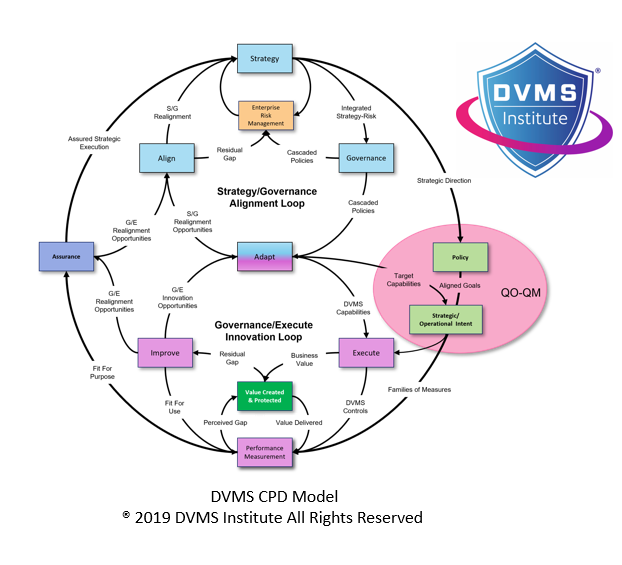Managed Service Providers (MSP’s) – Using the NIST-CSF and a Digital Value Management System (DVMS) To Make SMBs Cyber Resilient
Rick Lemieux – Co-Founder and Chief Product Officer of the DVMS Institute
In today’s digitally driven economy, small businesses face cybersecurity threats that were once reserved for large enterprises. However, these smaller organizations often lack the resources, expertise, and frameworks to build and sustain effective cybersecurity programs.
Managed Service Providers (MSPs) are increasingly stepping into this gap, providing cybersecurity services as an essential part of their offerings. To do this effectively and sustainably, MSPs must adopt approaches that are scalable, adaptable, and aligned with business outcomes. The combined use of the NIST Cybersecurity Framework (CSF) 2.0 and the Digital Value Management System® (DVMS) offers MSPs this advantage, enabling them to help small businesses achieve true cyber resilience while optimizing costs, minimizing complexity, and accelerating time to value.
The NIST Cybersecurity Framework provides a proven, outcomes-based structure that MSPs can use to build or improve the cybersecurity posture of small business clients. Its structure, centered around six critical Functions: Govern, Identify, Protect, Detect, Respond, and Recover, gives MSPs a common language to assess, design, and implement cybersecurity capabilities tailored to each client’s specific risk profile and business objectives.
Using the NIST CSF, MSPs can help small businesses move from ad hoc, reactive security practices to a mature, proactive, and strategic approach to cyber risk management. The Framework’s flexibility means it is sector- and size-neutral, which is particularly important for small businesses that operate in diverse industries with varying regulatory and operational requirements.
One of the key benefits the NIST CSF offers MSPs is the use of the Organizational Profiles. By developing a Current Profile and a Target Profile for each client, MSPs can document the client’s existing cybersecurity capabilities, assess gaps, and chart a prioritized action plan for improvement. This structured gap analysis enables MSPs to align cybersecurity initiatives with the client’s business goals, threat landscape, and risk appetite, rather than applying generic security solutions. It also provides a valuable basis for ongoing performance tracking, reporting, and continuous improvement, critical for client satisfaction and long-term retention. Small businesses benefit because they receive cybersecurity solutions that are right-sized and cost-effective, rather than being overburdened with unnecessary or misaligned controls.
While the NIST CSF provides the structure, the Digital Value Management System (DVMS) complements it by giving a systems-based overlay that integrates cybersecurity into the overall business strategy. The DVMS repositions cybersecurity not as a technical issue handled by IT alone, but as an enterprise-wide concern tied directly to value creation and protection. For MSPs, this perspective is transformative. It enables them to frame cybersecurity services to small businesses as a strategic enabler of business resilience, customer trust, and digital growth. This repositioning helps MSPs move beyond being seen as a technical vendor to becoming a strategic advisor—a shift that can increase client loyalty and service margins.
The DVMS introduces Minimum Viable Capabilities (MVCs)—Govern, Assure, Plan, Design, Change, Execute, and Innovate—which MSPs can use to map a client’s existing business and IT functions. This mapping makes it easier to identify where cybersecurity needs to be embedded without requiring disruptive overhauls. By overlaying the DVMS onto a small business’s current practices, MSPs help clients evolve their cybersecurity maturity in manageable, incremental steps, reducing resistance to change and lowering costs. The DVMS’ FastTrack™ phased approach—moving through stages like Initiate, Basic Hygiene, Expand, and Innovate—gives MSPs a blueprint for delivering cybersecurity improvements in digestible, value-driven increments, ideal for small businesses with limited resources
Another significant advantage of DVMS is its strong emphasis on systems thinking and cultural change. Small businesses often struggle not because they lack tools, but because they lack cybersecurity culture and coherent systems to manage digital risk. By applying the DVMS, MSPs can guide small business leadership in seeing cybersecurity as part of overall business quality, governance, and resilience, rather than an isolated technical concern. Systems thinking allows MSPs to design integrated cybersecurity programs across business operations rather than bolted on afterward. This reduces complexity, eliminates redundant efforts, and makes cybersecurity practices stickier and more sustainable within the client organization.
Furthermore, the DVMS enables risk-informed decision-making through the QO-QM (Question Outcome–Question Metric) methodology. For MSPs, this offers a structured way to connect cybersecurity actions directly to business outcomes, such as uptime, customer satisfaction, or regulatory compliance. Instead of selling cybersecurity services based on fear or uncertainty, MSPs can demonstrate clear business value. This clarity makes it easier for small businesses to justify cybersecurity investments and ensures that every dollar spent contributes to measurable improvements in business resilience.
The CSF’s Tiers model provides MSPs a flexible maturity path for clients. MSPs can create achievable cybersecurity roadmaps that are aligned with the client’s growth by helping small businesses progress through Tiers—from Partial (Tier 1) to Adaptive (Tier 4). This staged approach means small businesses are not overwhelmed with unattainable security goals. Instead, they build capabilities progressively, supported by regular reassessments and refinements, which reduces operational risks and maximizes return on investment.
Notably, the DVMS and NIST CSF support continuous improvement rather than a static compliance exercise. Small businesses operate in dynamic environments where threat landscapes, technologies, and regulations constantly evolve. The DVMS emphasis on continual learning, innovation, and systems adaptation ensures that cybersecurity practices do not become obsolete but evolve alongside the business. For MSPs, the DVMS creates opportunities to offer ongoing value through managed security services, virtual CISO services, security awareness training, risk assessments, and incident response planning, all aligned with the client’s evolving needs.
Lastly, the combined NIST CSF and DVMS approach democratizes cybersecurity for small businesses. It brings the same disciplined, enterprise-grade thinking used by large corporations to small organizations, but in a scalable, understandable, and manageable way. MSPs become the enablers of this transformation. By using proven frameworks and holistic, adaptable methodologies, MSPs can systematically build cyber-resilient small businesses without requiring them to have large internal security teams or massive IT budgets.
The NIST Cybersecurity Framework and the Digital Value Management System empower Managed Service Providers to help small businesses achieve cyber resilience effectively and affordably. By combining structured risk management, business-aligned cybersecurity integration, incremental improvement pathways, and a focus on outcomes over controls, MSPs can deliver cybersecurity services that are practical, scalable, and deeply valuable to small businesses. In doing so, they protect their clients and enable them to thrive securely in a volatile digital landscape.
About the Author

Rick Lemieux
Co-Founder and Chief Product Officer of the DVMS Institute
DVMS Institute is a renowned provider of accredited (APMG International), Assured (NCSC-GCHQ-UK), and Recognized (DHS-CISA-NICCS-USA) NIST Cybersecurity Framework, Digital Value Management System® body of knowledge publications, certification trainings, assessment platforms and real-life desktop simulation trainings.
The Institute’s NIST Cybersecurity Framework Digital Value Management System® certified training programs teach businesses of any size, scale, or complexity the skills to build a Holistic, Adaptive, and Culture-Powered Overlay System capable of anticipating and mitigating the systemic risk that will impact organizational cyber resilience.
By embedding systemic risk management into strategic decision-making and aligning it with employee cultural values, organizations can build resilience—a dynamic capability to withstand digital business disruption and comply with any cybersecurity regulation (SEC, UK, DORA, NIS2, SAMA, SOCI, IMO, etc.) or maturity model mandates (HITRUST, CMMC, C2M2 etc.).
® DVMS Institute 2024 All Rights Reserved




